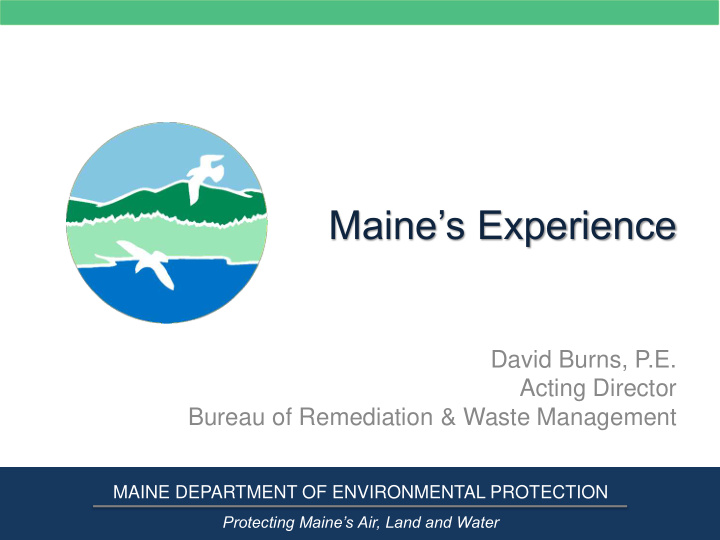



Maine’s Experience David Burns, P.E. Acting Director Bureau of Remediation & Waste Management MAINE DEPARTMENT OF ENVIRONMENTAL PROTECTION Protecting Maine’s Air, Land and Water
Actions Taken Through 5/15/2019 • April 2, 2017 – DEP established a hierarchy to prioritize investigation of PFAS in drinking water • Developed SOP for sampling and analysis of PFAS • Utilizing EPA’s 70 ppt health advisory level for drinking water supplies • Established meetings with Maine’s Drinking Water Program staff MAINE DEPARTMENT OF ENVIRONMENTAL PROTECTION www.maine.gov/dep
Actions Taken Through 5/15/2019 • PFAS testing: – active remediation sites where drinking water is known to be impacted and the Department suspects PFAS may be present at the source due to site history – remediation sites with potential at-risk drinking water supplies – prior to closing out sites that have been otherwise remediated and a risk factor exists – Biosolids associated with land application or composting – EPA 5-year review sites MAINE DEPARTMENT OF ENVIRONMENTAL PROTECTION www.maine.gov/dep
Actions Taken Through 5/15/2019 • Worked with ME CDC to evaluate risk by establishing screening levels as well as to evaluate risk at individual remediation sites. • In conjunction with ME CDC, established limited PFAS screening levels in RAGs and Chapter 418 (PFOA, PFOS, & PFBS) • Discussing ways to inventory AFFF stockpiles in Maine to determine extent. Firefighting foam use and associated MDEP response
Case Study – Corinna Landfill
Biosolids Testing Requirement • March 22, 2019 letter to facilities that compost or land apply biosolids • Through 5/17, received results from 40% of facilities required to report. Expect most results will be submitted sometime in June • Results compared to Ch. 418 Appendix A
State Responses • States have set or proposed MCLs (includes NJ, NY, VT, NC, NH) or various health advisories • States have listed PFAS as hazardous substances (includes VT, NY, NJ) • New Jersey directive to manufacturers – https://www.nj.gov/dep/docs/statewide-pfas-directive-20190325.pdf • https://pfas-1.itrcweb.org/fact-sheets/
MDEP Regulatory Authority • Limited authority available under Chapters 418 & 419 of solid waste rules (PFOA, PFOS, PFBS) • Stakeholder process to modify Chapter 800 to list PFAS compounds as hazardous matter. • Air Bureau authority under 38 MRS 585-B to establish standards or work practices for HAPs • Water Bureau – Chapters 521 & 523
Sampling, Analysis, & Remediation Funding • Money expended to date mostly related to solid waste work and remediation sites • Funding authority when PFAS compounds are the only known contaminant? • Measured approach to date, have been able to absorb costs within existing budgets • Future funding mechanisms? MAINE DEPARTMENT OF ENVIRONMENTAL PROTECTION www.maine.gov/dep
Contact: David Burns, P.E. Dave.E.Burns@maine.gov 207-287-7890 www.maine.gov/dep
Recommend
More recommend